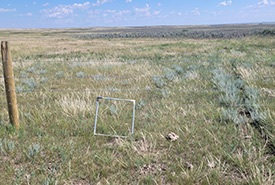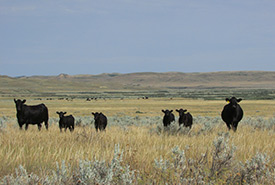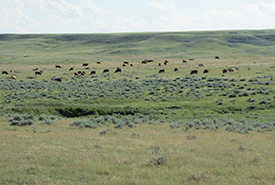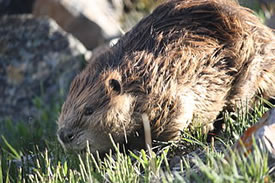NCC: Land Lines – It’s a wall! It’s a fence! No, wait, it’s a conservation tool!

Wildlife friendly fence. You can see where the fence bisected a cattle trail, and will change how cattle move across that piece of land. (Photo by NCC)
There could be a joke that starts like this: a wildlife biologist and a rancher stand looking at a fence….
If you’re familiar with all the ways biologists and ranchers push and pull over what types of infrastructure developments are supportive or detrimental for biodiversity conservation, you’ll recognize that there’s comedy gold somewhere in that scenario. As the manager of the Nature Conservancy of Canada’s (NCC’s) Working Landscapes program in Saskatchewan, I’ve spent many spring days looking at fences, thinking about fences, and scrambling through fences because I’m too lazy to open the gate.
A typical fence used for managing livestock isn’t a wall. It’s permeable for some animals — I can fit between the wires, a white-tailed deer can bounce over it, and a pronghorn antelope can duck under it, but it holds domestic livestock where we want them. You’re probably wondering, “Why write a blog post about fences? What does this have to do with conservation?”
Grazing and grassland health
Grazing is an important ecosystem process and is part of what has kept grasslands healthy for millennia. Prairie plants and grazers have co-evolved. For as long as there have been people inhabiting grasslands, there has been an interaction between grazing animals, plants and human management that has helped maintain productive and diverse grasslands and has been central to human culture. The dominant species of grazing animals on North American grasslands have changed with time and the eventual introduction of domestic livestock, but the ecosystem services of grazing remains critical for maintaining healthy grasslands.
Don’t fence me in

Cattle on native prairie grassland, SK (Photo by NCC)
When you imagine beef cattle out grazing on summer pasture, what infrastructure do you see in your mind’s eye that makes it possible? Perhaps there is a dugout, or a water trough filled by a shallow buried water pipeline. There is likely a fence, and the most common type of fence would be a three- or four-strand barbed-wire fence with wooden posts. There is likely a series of fences, so that the cattle can graze in one area while the plants elsewhere recover and regrow from the previous grazing event.
Poorly placed, poorly designed infrastructure can increase predation, injure wildlife or create barriers to daily wildlife movement or seasonal migration. But a well-designed grazing plan using infrastructure designed to lessen any potential harms to wildlife can give ranchers the ability to control the timing, duration and intensity of grazing. This can have beneficial impacts on the structure and composition of the grassland plant community. An example of a common wildlife-friendly fence strategy is to install the bottom wire of the fence a bit higher (about 46 centimetres from the ground) and use a smooth wire to ensure that pronghorns can easily duck beneath the fence without being injured. This action reduces the most critical risks, while still resulting in a fence that will effectively hold cattle where intended.
Clever cattle
Cattle have a remarkable ability to sense direction and time of year, and often follow annual patterns of movement. For example, they can be aware that their usual wintering site is to the north, and they will spend more time in the north end of the field they are in, in anticipation of moving home soon, resulting in heavier grazing impact to the plants and soil. Cattle will also select different parts of a field based on the amount of available food, nutritional quality, and water availability.
Without tools to manage where cattle are grazing, their grazing behaviours often result in repeated concentration of grazing in the same areas, year after year, and the avoidance of other areas. This repeated grazing can contribute to shifts in plant community composition and decrease forage production over time.
Working together for grassland health

The ecosystem services of grazing remains critical for maintaining healthy grasslands. (Photo by NCC)
By working together to support best management practices on grazing lands, we can help protect biodiversity while supporting a strong livestock industry. NCC is collaborating with numerous community pasture grazing groups across Saskatchewan, to encourage activities on the land that support and enhance biodiversity. These partnerships have also provided NCC with a unique opportunity to learn from the communities’ nearly 100 years of grazing management knowledge. In addition to sharing information and learning from one another, NCC is helping to deliver a program that supports the good management of grasslands.
Investing in healthy stewardship
The Weston Family Prairie Grasslands Initiative’s Stewardship Investment Program awards grants for projects that result in mutually beneficial outcomes for ranching and biodiversity conservation. While the program can award grants for a wide variety of projects, most of the projects completed by grazing groups working with NCC have involved developing infrastructure to help manage grazing distribution or stock water availability while protecting native prairie and natural wetlands.
Electric fences are just one example of a common fencing project supported by the Stewardship Investment Program. Manufacturers are building all-in-one units that are relatively easy to set up, take down and move, and are highly visible to wildlife. Portable electric fences allow people to target grazing to a specific prescription and change that targeted area quickly and easily. Flexibility is needed to effectively apply adaptive management to a complex grassland resource, targeting grazing to specific areas where it can be used to achieve specific forage and wildlife habitat management goals. To learn more, watch the following video:
In addition to portable and wildlife friendly permanent fence, The Weston Family Stewardship Initiative Program funds projects such as shallow buried water pipeline, dugouts to capture spring runoff, portable solar water pumps and troughs to prevent cattle from damaging sensitive wetlands or dugout banks, invasive plant control, prescribed fire, and more. For more information about the Stewardship Investment Program, visit prairiegrasslandsinitiative.ca. If you would like to know more about NCC’s Working Landscapes program, I’d love to hear from you. Email me at saskatchewan@natureconservancy.ca.




